Morocco: The ‘Goldilocks’ Zone
Updated 24th January 2023
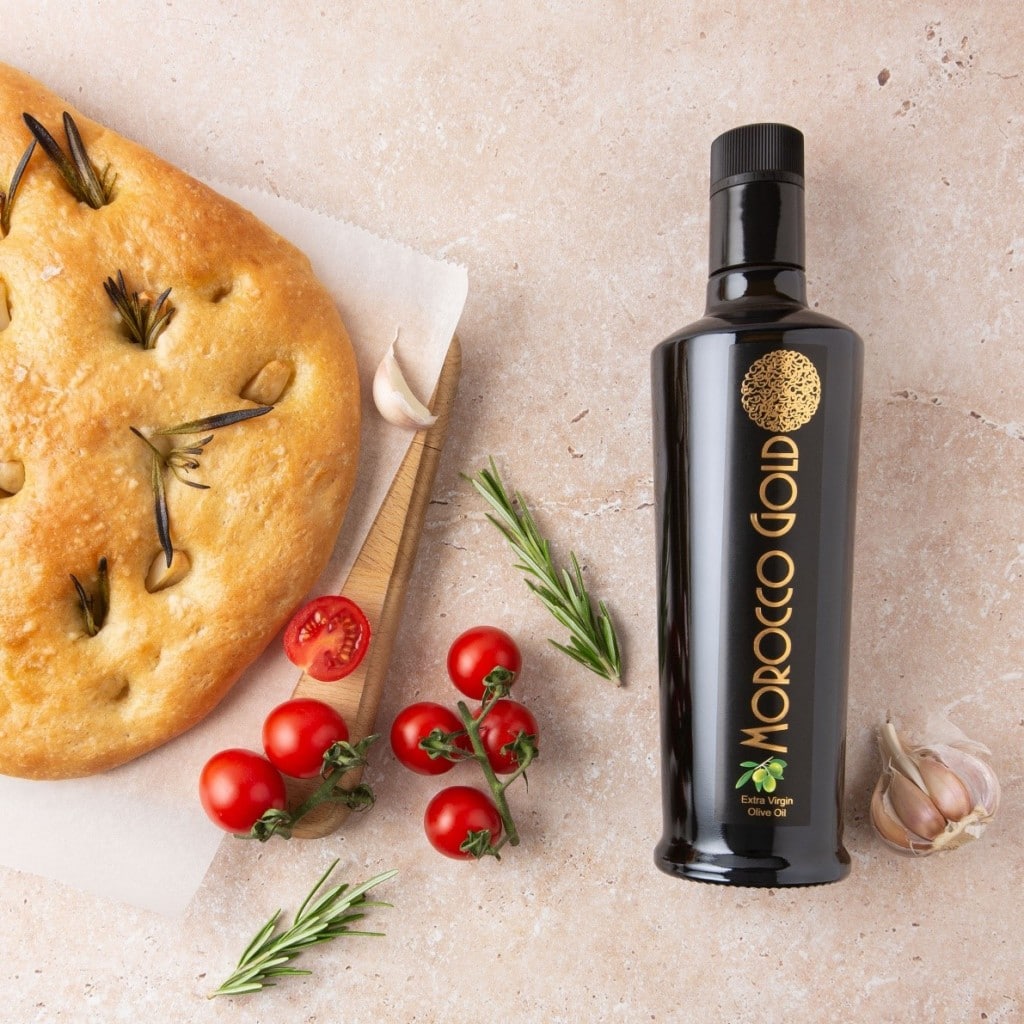
Although we believe that Moroccan olive oil truly is the best olive oil for health and flavour, we want you to understand why. And it all starts the moment we plant our crops.
One of the key factors in what makes Morocco Gold one of the best olive oils you can buy is the quantity of polyphenols present in the end product. But making this happen so that our customers enjoy the benefits of olive oil with every drizzle and dip takes time and attention.
What Makes Olive Oil From Morocco So Special?
The ‘Goldilocks’ Zone
To begin with, the quality of Moroccan Olive Oil benefits hugely from the environment in which the olive trees grow.
The remote, elevated valley in the foothills of the Atlas Mountains where Morocco Gold extra virgin olive oil comes from provides the ideal balance of temperature and growing conditions throughout the olive growing season.
Olive trees require temperatures that are – not too hot – not to cold – but just right!. They require winter cold to achieve normal blooming and fruiting. Strong winds, hot temperatures, and freezing temperatures can negatively impact fruit set. Particularly cold springs will negatively impact harvest by delaying blooming and increasing flower abnormalities. Localized winter temperature rises due to development around the tree such as buildings and asphalt can act as a wintertime heat sink, thereby inhibiting fruiting. The remote, elevated valley in the foothills of the Atlas Mountains where Morocco Gold extra virgin olive oil comes from provides the ideal balance of temperature and growing conditions throughout the olive growing season.
Olive trees can produce olives for hundreds of years. Yet olive trees typically alternate between bearing small crops and normal crops every other year. They can also go for 2 – 3 years without bearing any fruit. There are a number of key stages in the life cycle of the olive tree that lead up to the harvesting and pressing of our extra virgin olive oil.
Interflorescences
Olive trees produce fruiting shoots called inflorescences, which originate at the axil of a leaf. Each inflorescence will typically contain 10 to 30 flowers depending on the type of olive. The number of flowers that then mature into olives dependent on a number of factors.
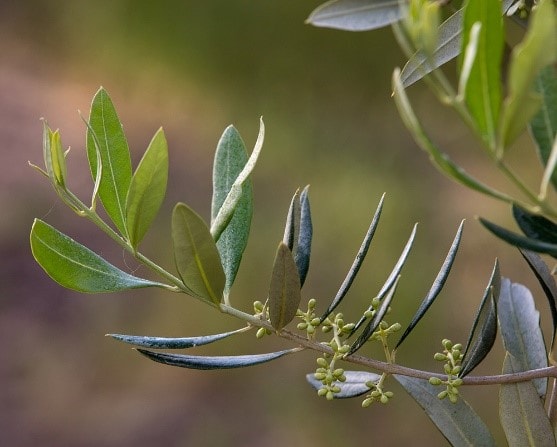
Olive trees produce fruiting shoots called inflorescences, which originate at the axil of a leaf. Each inflorescence will typically contain 10 to 30 flowers depending on the type of olive. The number of flowers that then mature into olives dependent on several factors.
Bud Differentiation
Before flowers bloom, they go through a differentiation period that has to do with the sexuality of the blooms. This generally takes place June through July and results in one of two results (although there is some new research indicating that there may be a third possible result).
Perfect Flowers: flowers which have both stamen (the male part) and pistil (the female part).
Staminate Flowers: flowers which have only stamens and lack a pistil (which apparently have been aborted).
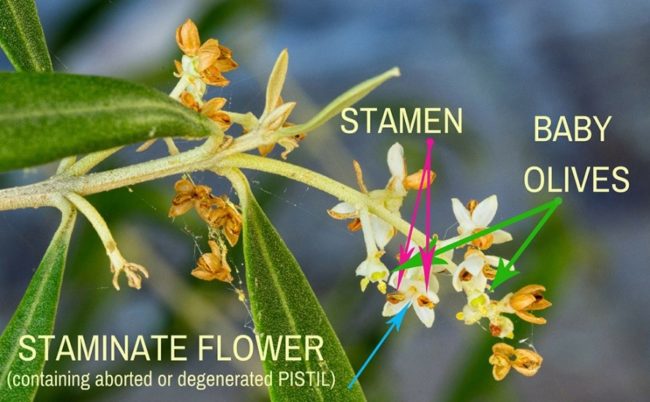
Why are there staminate flowers and not just perfect (hermaphroditic) flowers? There are a number of theories and reasons, but the main ones are thought to be :
- It takes a great deal of energy to develop the pistil (or ovule – think of this like the human ovum). The tree has to moderate the number of pistils it is able to develop with the nutrients available to it.
- In order to pollinate the pistil, the tree is dependent on a high volume of stamens – stamens don’t have the same nutrient requirements as the pistils, so the tree exercises her “nutrient economizing” by terminating pistils (ovules) as needed.
Orchard stress, in particular water stress, can negatively impact this portion of development. In competitions between flowers and leaves, the leaves win, and the first floral part to fail is the pistil. A moist soil profile during this period can help prevent this kind of stress.
Pistil abortion occurs naturally and is not perfectly understood. Pistil formation must compete with vegetative growth for nutrients at a time when both are working their hardest. In addition, following a big harvest year, the tree’s nutritional resources have been depleted. Yet, if only 1% – 2% of the flowers are able to set fruit, the grower will still enjoy a satisfactory crop. If a tree is blooming, but no olives develop, this could be because of a mechanical disruption to fruit set. Wind, rain, and/or hail can knock off the blooms just at this critical time of the year.
Blooming
According to the Olive Production Manual (University of California, Agriculture and Natural Resources), “…some 500,000 flowers are present in a mature tree…” at time of full bloom. Within two weeks of full bloom, most of the flowers will have failed, with only 1 – 2% then maturing into full-grown fruit.
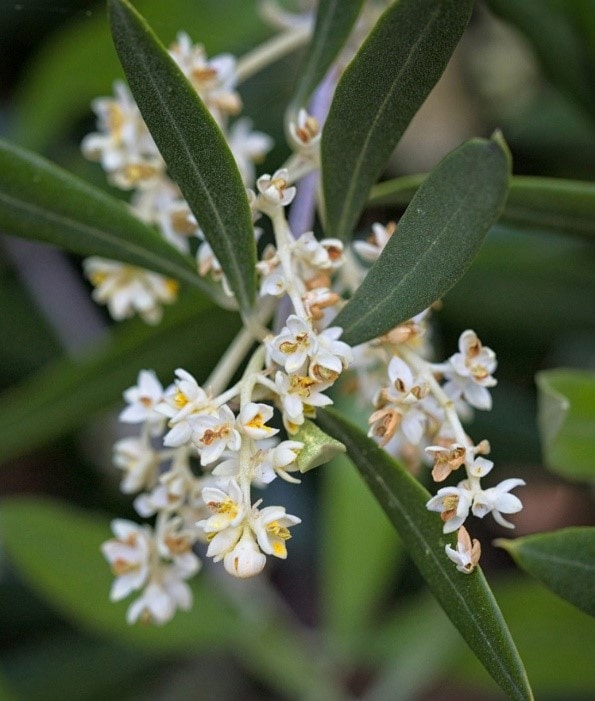
Self-Pollination
Because of their geometry, olive flowers self-pollinate. The anthers (located at the top of the filaments attached to the stamen) drop pollen on the stigma of the pistil. The pollen grains germinate and olive growth is underway. Though not necessary for pollination, wind and bees may aid in pollination by disturbing the flower causing pollen to fall from the anther to the stigma. Many olive varieties cannot self-pollinate. For these trees, olive pollen is primarily carried by wind. Bees may play a minor role in pollination.
Cross Pollination
Cross-pollination occurs when wind or a bee transfers pollen from one flower to the stigma of another flower. As bees are not particularly fond of olive flowers, they do not typically play a large role in the olive orchard.
The Growth Cycle
The following indicates when each part of the growth cycle typically occurs. We are now at the point where flowering has occurred, the fruit has formed or set the fruit is in its growth stage and pit hardening is occurring.
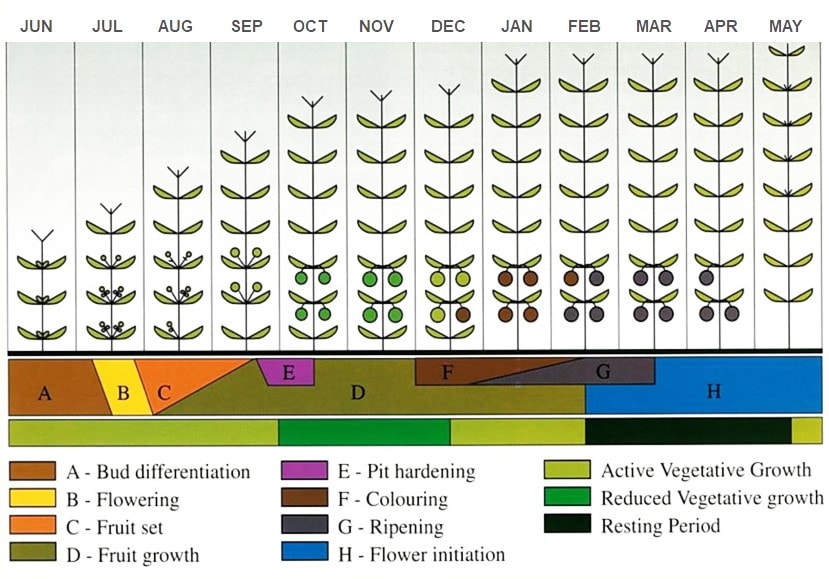
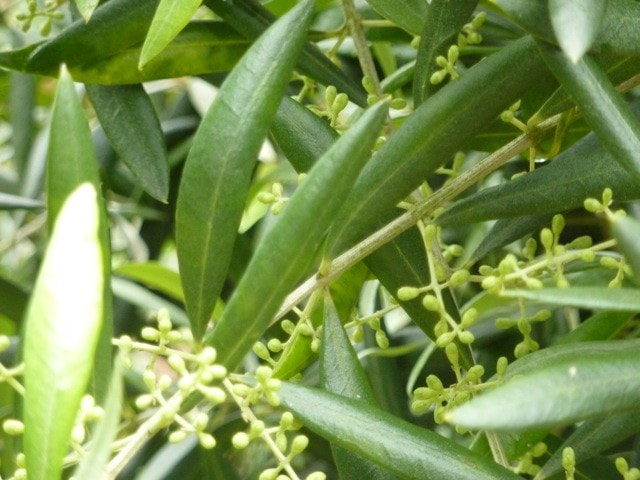
By: Jaouad Hadani : Director Morocco Gold Ltd.
